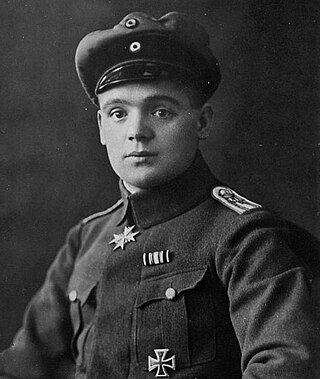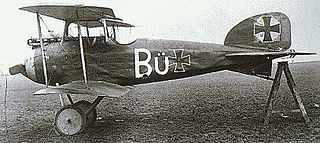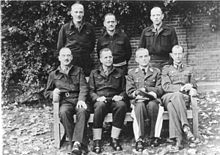
Robert Ritter von Greim was a German Generalfeldmarschall and First World War flying ace. In April 1945, in the last days of World War II in Europe, Adolf Hitler appointed Greim commander-in-chief of the Luftwaffe after Hermann Göring had been dismissed for treason. He is the last person ever promoted to field marshal in the German armed forces. After the surrender of Nazi Germany in May 1945, Greim was captured by the Allies. He committed suicide in an American-controlled prison on 24 May 1945.

Julius Buckler was a German First World War fighter ace credited with 36 victories during the war. He shot down 29 enemy airplanes and seven observation balloons; two other victories went unconfirmed. He was one of only four German fighter aces to win Germany's highest decorations for valor for both enlisted man and officer.

Theodor "Theo" Osterkamp was a German fighter pilot during World War I and World War II. A flying ace, he achieved 32 victories in World War I. In World War II, he led Jagdgeschwader 51 up to the Battle of Britain and claimed a further six victories during World War II, in the process becoming one of only a few men to score victories and become an ace in both world wars.

Günther Korten was a German Colonel General and Chief of the General Staff of the Luftwaffe in World War II. He died from injuries suffered in the assassination attempt on Adolf Hitler on 20 July 1944.

Walther Wever was a Luftwaffe flying ace during the Second World War. The son of former Chief of the Luftwaffe General Walther Wever, Wever served during 1943 on the Eastern Front and from 19 June 1943 until 10 April 1945 he claimed 44 aerial victories in 250 combat missions. He was also a recipient of the Knight's Cross of the Iron Cross.

Walter Blume was a German fighter ace of World War I. During World War I, he flew with two fighter squadrons, Jagdstaffel 26 and Jagdstaffel 9 gaining 28 aerial victories and earning the Iron Cross, Royal House Order of Hohenzollern, and the Pour le Merite.
Gerhard Vogt was a German Luftwaffe military aviator and fighter ace during World War II. He is credited with 48 aerial victories, claimed over the Western Front and in Defense of the Reich in 174 combat missions.

Rittmeister Carl Bolle, PlM, MMC, HOH, IC, was a fighter ace with 36 aerial victories during World War I. He became a Jagdstaffel commander during that war, and an advisor to the Luftwaffe during World War II.

Jasta 2 was one of the best-known German Luftstreitkräfte squadrons in World War I. Its first commanding officer was the great aerial tactician Oswald Boelcke, and it was the incubator of several notable aviation careers.
Generalmajor Hermann Frommherz Military Order of St. Henry, Royal House Order of Hohenzollern, Knight's Cross of the Military Karl-Friedrich Merit Order, began his military career in World War I as a German ace fighter pilot. He was credited with 32 victories. During World War II he was involved in the German takeover of Czechoslovakia and rose to become a Luftwaffe Generalmajor.

Adolf Ritter von Tutschek (16 May 1891 – 15 March 1918) PlM, MOMJ was a professional soldier turned aviator. As German air strategy turned towards concentrated air power, he was entrusted with one of the world's first fighter wings.

Hans Kirschstein, winner of the Pour le Merite, Royal House Order of Hohenzollern, and the Iron Cross, 1st and 2nd class, was a German lieutenant and World War I flying ace credited with 27 aerial victories.
Friedrich Altemeier was a German World War I flying ace credited with 21 confirmed aerial victories. Due to his distinguished faithful military service and piloting skills, he became one of the test pilots for Germany's last and best fighter airplane of the war, the Fokker D.VIII.
Leutnant Hans-Georg August von der Osten began his career as a World War I flying ace credited with five aerial victories. He later rose to command of all Luftwaffe bases in Germany, during World War II.

Leutnant Otto Paul Wilhelm Höhne was a German World War I flying ace credited with six confirmed aerial victories. Höhne was a pioneer ace; he was the first pilot to score a victory while flying the Albatros D.1. During World War II he was a recipient of the Knight's Cross of the Iron Cross.
OberleutnantHans Waldhausen was a World War I flying ace credited with six confirmed aerial victories in eight days. He was forced down and captured after his sixth victory.

Johann (Hans) Schalk was a Nazi German flying ace and high-ranking officer in the German Luftwaffe during World War II. He is credited with 15 aerial victories, 4 of which on the Eastern Front, claimed in 163 combat missions.
Major Theodor Quandt was a World War I German flying ace credited with 15 aerial victories. He would return to his nation's service for World War II, being killed on 6 June 1940 during the Fall of France.
LeutnantPaul Strähle was a German World War I flying ace credited with 15 aerial victories.

Leutnant Hans Müller, alias Hans Garelt, was a German World War I flying ace credited with twelve aerial victories.














